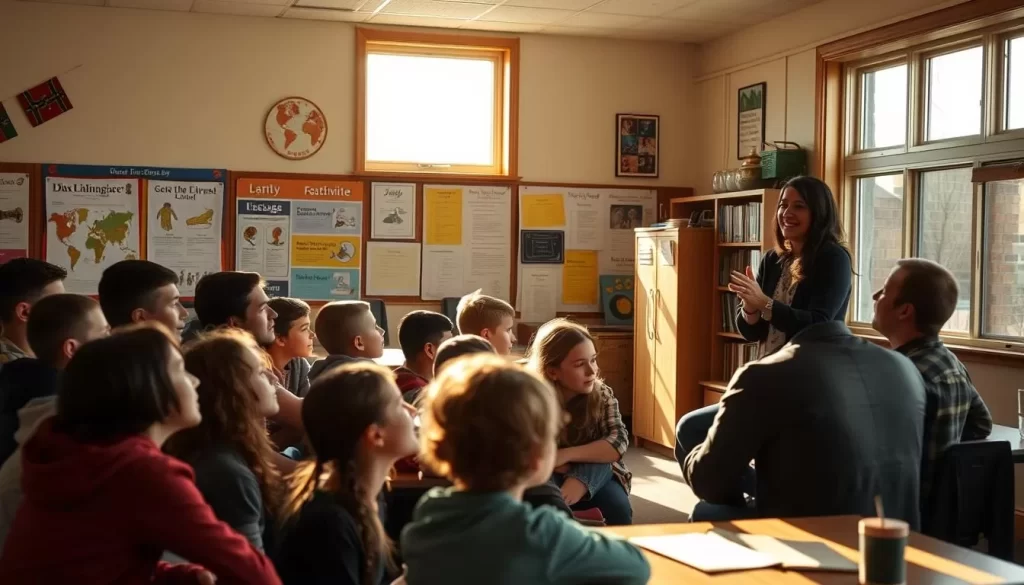✓ Accommodations✓ Flights✓ Rental Cars
When you think of Saskatchewan, you might not immediately consider its linguistic diversity. However, this Canadian province is home to a rich tapestry of languages. According to recent census data, English is the dominant language, used by 98.1% of the population as their first official language.
You might be surprised to learn that while English prevails, other languages also play significant roles in the daily lives of Saskatchewan’s residents. The province’s linguistic profile is shaped by its history, immigration patterns, and Indigenous cultures.
As you explore the linguistic landscape of this province, you’ll discover the complex dynamics between official languages, immigrant languages, and Indigenous tongues. This exploration will provide valuable information on how language influences cultural identity and community life.
The Linguistic Landscape of Saskatchewan
As you explore Saskatchewan, you’ll discover a complex linguistic landscape influenced by its Indigenous peoples, immigrants, and official language policies. The province’s language profile is shaped by its history, demographics, and government policies.
Demographics and Language Distribution
Saskatchewan’s population is predominantly English-speaking, with English being the main language used in daily life, government services, and the education system. However, the province is also home to a diverse range of languages, including French and various Indigenous languages.
The distribution of languages in Saskatchewan varies across different regions. While English is widely spoken throughout the province, other languages are more concentrated in specific areas, often reflecting the cultural heritage of the local communities.
| Language | Speakers | Regions |
|---|---|---|
| English | Predominant | Province-wide |
| French | Minority | Specific communities |
| Indigenous Languages | Varies | Reserves and some urban areas |
Language Policies in Saskatchewan
The government of Saskatchewan operates primarily in English, although some services are available in French and other languages in certain regions. Saskatchewan’s language policies differ from the federal level, where both English and French have official language status.
In education, the province offers French immersion programs and some Indigenous language instruction, promoting linguistic diversity. The policies regarding language rights and services aim to balance the needs of the dominant English-speaking population with those of linguistic minorities.
English: The Dominant Language
In Saskatchewan, English is not just a widely spoken language, but an integral part of the province’s identity. As the dominant language, it plays a crucial role in shaping the daily lives of residents, from education to business and social interactions.
Prevalence of English in Saskatchewan
English is the primary language used in most aspects of life in Saskatchewan. You will find that it is the predominant language in government services, education, media, and daily communication. The widespread use of English is a testament to its importance in uniting the province’s diverse population.
The prevalence of English is also reflected in the province’s demographic makeup. According to linguistic data, the vast majority of Saskatchewan’s residents speak English as their first or second language, making it a common tongue that bridges different cultural communities.
| Language Spoken at Home | Percentage of Population |
|---|---|
| English | 94.5% |
| Other Languages | 5.5% |
Canadian English Characteristics in Saskatchewan
Saskatchewan’s version of Canadian English has distinctive characteristics that set it apart from other dialects. The province’s English incorporates vocabulary and expressions influenced by its agricultural heritage and prairie landscape. For instance, terms related to farming and the natural environment are commonly used in everyday language.
The pronunciation of English in Saskatchewan features the Canadian Shift vowel pattern and the Canadian Raising of diphthongs, with some regional variations. You might notice that rural areas sometimes preserve older speech patterns and vocabulary that have faded in urban centers, adding to the richness of the language.
The influence of Indigenous languages and European immigrant languages has also contributed unique words and expressions to Saskatchewan English. As a result, the dialect reflects the cultural history and identity of the province, serving as a marker of regional belonging.
French Language Status and Usage
As you explore the linguistic landscape of Saskatchewan, you’ll discover the complex status and usage of the French language. The province has a unique history with the French language, which continues to evolve over time.
Historical Presence of French in Saskatchewan
French has been present in Saskatchewan for centuries, leaving a lasting impact on the province’s cultural identity. Historically, French-speaking communities were established, particularly in the rural areas. You can still see remnants of this history in the many French place names across the province.
The historical presence of French is not just a matter of geographical names; it’s also reflected in the cultural practices and traditions of the communities that have maintained their French heritage.
Current French-Speaking Communities
Today, French-speaking communities continue to exist in Saskatchewan, although their demographics have changed significantly. According to Statistics Canada, the number of people with French as their mother tongue has been declining. In 2021, 12,565 people reported French as their only native tongue, down from 16,280 in 2011.
You should be aware that the decline in French as a mother tongue is a trend observed not just in Saskatchewan but across Western Canada, outside of Quebec. Factors contributing to this decline include mixed-language marriages and the dominance of English in education and media.

Decline of French as a Mother Tongue
The decline of French as a mother tongue is particularly pronounced among younger generations. For children aged 0-14, the percentage of those with French as their mother tongue is less than half of one per cent, compared to 2.7% among those aged 65 and older.
This intergenerational decline reflects broader patterns, including weakened intergenerational language transmission. Many children of French-speaking parents are growing up with English as their primary language, contributing to the decline in the number of French mother tongue speakers.
Despite this decline, interest in French as a second language remains relatively strong in the province, indicating a potential for revitalization or maintenance of French language skills among Saskatchewan’s population.
Indigenous Languages in Saskatchewan
Indigenous languages in Saskatchewan are not just a part of the province’s history, but a living, breathing aspect of its cultural identity. You will find that the province is home to a diverse range of Indigenous languages, each with its own distinct characteristics and cultural significance.
Cree: The Most Widely Spoken Indigenous Language
Cree stands out as the most widely spoken Indigenous language in Saskatchewan. It is a vital part of the cultural heritage of many First Nations communities. Efforts to preserve and promote Cree include language education programs and cultural initiatives. You can see the importance of Cree in the daily lives of community members, from traditional ceremonies to modern educational settings.
The significance of Cree is further highlighted by its use in various aspects of community life, including in media, literature, and community events. As a result, Cree continues to thrive, with many community members proud to speak and pass on the language to younger generations.
Dene Languages and Their Communities
Dene languages, another important linguistic group in Saskatchewan, are spoken by communities across the province. These languages are integral to the identity and cultural practices of Dene people. While the number of Dene language speakers is smaller compared to Cree, there are still significant efforts underway to document, teach, and preserve Dene languages.
Community-based initiatives play a crucial role in the preservation of Dene languages, with programs aimed at teaching the languages to children and young adults. You will find that these efforts are crucial for maintaining the cultural heritage of Dene communities.
Preservation Efforts and Challenges
Despite the challenges, including the historical impact of residential schools, there are many positive developments in the preservation and revitalization of Indigenous languages in Saskatchewan. First Nations-controlled education systems have been at the forefront of implementing language nests, immersion programs, and curriculum development to pass languages to younger generations.
| Language Preservation Efforts | Description | Impact |
|---|---|---|
| Language Nests | Programs that immerse young children in Indigenous languages | Helps in early language acquisition |
| Immersion Programs | Educational programs that teach curriculum through Indigenous languages | Promotes fluency among students |
| Digital Resources | Development of language learning apps and online dictionaries | Increases accessibility to language learning |
As you can see, the preservation of Indigenous languages is a complex but ultimately rewarding endeavor. With continued support and community engagement, there’s hope for the long-term vitality of these languages.
Saskatchewan, Canada: Official and widely spoken languages in Comparison to Other Provinces
When comparing Saskatchewan’s linguistic landscape to other Canadian provinces, you’ll notice some distinct differences. Saskatchewan’s language demographics are shaped by its unique settlement history, economic development patterns, and demographic changes.
Language Policies Across Canadian Provinces
Language policies vary across Canadian provinces, reflecting their diverse linguistic landscapes. While some provinces like Quebec have strict language laws favoring French, others have more diverse language policies. In Saskatchewan, the language policy is influenced by its significant Indigenous population and growing immigrant communities.
For instance, the province has seen a significant growth in Asian languages, particularly Tagalog and Punjabi, at rates that exceed some other provinces. This growth is reflected in the language policies, with efforts to accommodate the linguistic diversity.
| Province | Predominant Language at Home | Percentage |
|---|---|---|
| Saskatchewan | English | 88.8% |
| Saskatchewan | French | 0.3% |
| Saskatchewan | Other Languages | 8.1% |
| British Columbia | English | 70.5% |
| British Columbia | Punjabi | 4.6% |
Saskatchewan’s Unique Language Situation
Saskatchewan has one of the lowest rates of French-English bilingualism among Canadian provinces, with only about 5% of the population able to speak both official languages. The province also has the lowest French language continuity ratio in Canada, at just 0.25 in 2021.
Unlike Manitoba and Ontario, which have significant francophone regions, Saskatchewan’s French-speaking population is more dispersed throughout the province. However, Saskatchewan has a higher proportion of Indigenous language speakers than many other provinces, particularly in northern communities.
The unique linguistic characteristics of Saskatchewan reflect its distinct settlement history and demographic changes. As the province continues to evolve, its language situation will likely continue to shift, with implications for language policies and community programs.
The Rise of Immigrant Languages
As immigration continues to shape Saskatchewan, the linguistic landscape is becoming increasingly diverse. Statistics Canada has noted a significant increase in the number of people who predominantly speak a language other than Canada’s official languages at home, rising to 8.1% from 7.4%. This trend is part of a broader national shift, with Canada seeing a 12 to 13% increase in people with a mother tongue other than English or French.

Tagalog and Filipino Communities
The Tagalog language, spoken by Filipino communities, has seen considerable growth in Saskatchewan. As one of the most common non-official languages spoken at home, Tagalog reflects the increasing presence of Filipino immigrants. You can see the impact of this growth in various urban centers, where Filipino communities are establishing cultural and social networks. The rise of Tagalog is a testament to the diverse immigration patterns that are reshaping the province’s linguistic identity.
Punjabi and South Asian Languages
Punjabi and other South Asian languages are also becoming more prevalent in Saskatchewan. The growth of these languages is linked to increased immigration from South Asia, contributing to the province’s cultural and linguistic diversity. As a result, you may notice an increasing number of community events, cultural festivals, and language classes centered around these languages, enriching the social fabric of the region.
Other Growing Language Communities
Beyond Tagalog and Punjabi, numerous other immigrant languages are on the rise in Saskatchewan. For instance, Arabic has grown significantly due to increased immigration from Middle Eastern countries, particularly Syria, as part of refugee resettlement programs. Additionally, Mandarin and Cantonese speakers have established vibrant communities in larger urban centers. Languages from African countries, such as Swahili, Somali, and Amharic, are also becoming more common, reflecting the diverse immigration patterns. Furthermore, Spanish speakers from Latin American countries are forming another growing linguistic community in Saskatchewan’s urban areas.
| Language | Primary Regions of Origin | Notable Trends |
|---|---|---|
| Tagalog | Philippines | Growing community presence, cultural events |
| Punjabi | South Asia (Punjab region) | Increasing cultural festivals, language classes |
| Arabic | Middle East (Syria) | Significant growth due to refugee resettlement |
| Mandarin/Cantonese | China | Established communities in urban centers |
| Swahili, Somali, Amharic | Various African countries | Diverse immigration patterns, growing linguistic diversity |
| Spanish | Latin America | Growing linguistic community in urban areas |
These diverse language communities are a reflection of Saskatchewan’s changing immigration patterns, contributing to the province’s multicultural character in ways that weren’t evident even a decade ago. As you explore the linguistic landscape of Saskatchewan, you’ll find that the rise of immigrant languages is not only changing the demographics but also enriching the cultural identity of the region.
German and Ukrainian: Historical Immigrant Languages
As you explore the linguistic landscape of Saskatchewan, you’ll discover the significant impact of historical immigrant languages. The province’s cultural identity has been shaped by various languages, with German and Ukrainian being prominent examples.
German-Speaking Communities and Their Decline
German-speaking communities have a rich history in Saskatchewan, with many Germans settling in the province during the late 19th and early 20th centuries. At their peak, these communities contributed significantly to the linguistic diversity of the region. However, over time, the number of German speakers has declined as language shift occurred, with English becoming the dominant language for many daily activities.
You might notice that the decline in German speakers reflects a broader trend among immigrant communities, where subsequent generations often adopt the dominant local language. Despite this decline, remnants of German language and culture remain in various parts of Saskatchewan, preserved through cultural events and community activities.
- German language heritage is still visible in the province’s cultural festivals and traditional practices.
- The influence of German can be seen in the architecture and place names across Saskatchewan.
- Efforts to preserve German language and culture continue through community programs and cultural organizations.
Ukrainian Language Heritage in Saskatchewan
Ukrainian has deep roots in Saskatchewan, dating back to the major waves of Ukrainian immigration in the late 19th and early 20th centuries. These immigrants established numerous farming communities, particularly in the east-central part of the province. While census data shows a decline in Ukrainian speakers from 11,000 to 8,000 between 2016 and 2021, the Ukrainian language heritage remains vibrant.
You can observe that Ukrainian language heritage is preserved through various cultural organizations, dance groups, choirs, and Ukrainian Catholic and Orthodox churches. Ukrainian Saturday schools and language programs continue to teach the language to younger generations, primarily as a second language. The recent arrival of refugees from Ukraine may potentially increase the number of Ukrainian speakers in the coming years.
- Ukrainian place names are common in the Saskatchewan landscape, reflecting the historical significance of Ukrainian settlement.
- Cultural events and festivals continue to celebrate Ukrainian heritage, keeping the language and traditions alive.
- The Ukrainian community remains active in preserving its language and cultural practices.
Bilingualism and Multilingualism in Saskatchewan
You’ll find that bilingualism and multilingualism are becoming increasingly prevalent in Saskatchewan. This phenomenon is particularly noticeable in immigrant communities and among Indigenous populations.
Rates of English-French Bilingualism
English-French bilingualism is an important aspect of Canada’s linguistic identity. In Saskatchewan, the rate of English-French bilingualism is significant, particularly among certain demographic groups. According to recent data, a notable percentage of the population is able to converse in both English and French, reflecting the province’s commitment to Canada’s official languages.
| Language | Speakers | Percentage of Population |
|---|---|---|
| English | 985,000 | 95% |
| French | 17,000 | 1.7% |
| English-French Bilingual | 43,000 | 4.2% |
Multilingual Speakers and Communities
Multilingualism is a common feature of many communities in Saskatchewan, particularly in urban centers like Regina and Saskatoon. Many residents speak multiple languages, including their mother tongue, English, and sometimes French. For instance, in immigrant families, children often develop as balanced bilinguals, speaking both English and their heritage language with native-like proficiency.
The growing multilingualism in Saskatchewan enriches the province’s cultural landscape and provides valuable linguistic resources. As the province continues to diversify, the importance of multilingualism is likely to grow, fostering greater understanding and connectivity within the community.
Language Education in Saskatchewan
You can explore a wide range of language education programs in Saskatchewan, reflecting the province’s cultural diversity. The education system supports various languages, including French, Indigenous languages, and heritage languages, ensuring that students have access to linguistic and cultural resources.
French Immersion Programs
French immersion programs are a significant part of Saskatchewan’s language education landscape. These programs, offered from elementary to high school, aim to develop proficiency in French while promoting cultural understanding. By participating in French immersion, you can gain a deeper appreciation of Canada’s official languages and enhance your career opportunities.
Indigenous Language Education
Indigenous language education is another vital aspect of Saskatchewan’s linguistic diversity. Programs focusing on Cree, Dene, and other Indigenous languages help preserve the cultural heritage of Indigenous communities. These initiatives not only teach language skills but also promote cultural awareness and understanding among students.

Heritage Language Programs
Heritage language programs in Saskatchewan support the linguistic diversity of immigrant communities. The Saskatchewan Organization for Heritage Languages (SOHL) coordinates community-based language schools for numerous languages, including Ukrainian, German, Punjabi, and Tagalog. These programs operate outside regular school hours and are supported by community organizations, helping to maintain cultural connections and transmit heritage languages to younger generations.
| Language Program | Description | Target Audience |
|---|---|---|
| French Immersion | Develops proficiency in French and promotes cultural understanding | Elementary to High School Students |
| Indigenous Language Education | Preserves Indigenous languages and cultural heritage | Students from Indigenous Communities |
| Heritage Language Programs | Maintains linguistic diversity among immigrant communities | Students from diverse linguistic backgrounds |
As Santos Ong noted, “Your culture and your language specifically is something that’s part of you. It’s really important to keep that culture alive no matter where you live.” This sentiment underscores the importance of language education in Saskatchewan, which not only teaches languages but also fosters cultural identity and community cohesion.
The Impact of Immigration on Language Diversity
Immigration patterns have played a crucial role in shaping the linguistic diversity of Saskatchewan. As newcomers arrive, they bring with them their languages and cultural practices, enriching the province’s linguistic landscape.
Recent Immigration Patterns
You may know that Saskatchewan has experienced shifts in immigration patterns over the years, influencing the languages spoken within the province. Recent immigrants come from diverse backgrounds, contributing to the growth of various language communities. Language training programs, such as Language Instruction for Newcomers to Canada (LINC), are available to support English language acquisition, a crucial step for social and economic integration.
Integration and Language Adaptation
As you settle in Saskatchewan, many immigrants follow a pattern of language adaptation, maintaining their heritage language at home while developing English language proficiency for work and public life. You might notice that children of immigrants often become bilingual more quickly than their parents, sometimes serving as language brokers for family interactions with English-speaking institutions. The speed and extent of language adaptation vary based on factors such as age at arrival, education level, occupation, and the size of the local heritage language community.
Over time, many immigrant families experience a generational shift toward English dominance, though efforts to maintain heritage languages continue through community initiatives. Settlement organizations provide crucial language support services, including interpretation and translation, to help newcomers navigate systems during their language learning journey.
Language Continuity and Shift
As you explore the linguistic landscape of Saskatchewan, you’ll notice the dynamics of language continuity and shift. The province’s diverse languages are influenced by various factors that contribute to their maintenance or decline.
Language retention varies significantly among different communities in Saskatchewan. For instance, the proportion of people who have French as their mother tongue is higher among older individuals than younger ones, indicating a potential decline in French language usage over time, as noted by Ouellet-Léveillé.
Language Retention Among Different Communities
Different communities in Saskatchewan exhibit varying levels of language retention. The presence of strong community ties and cultural institutions plays a crucial role in maintaining minority languages. For example, languages like Cree and other Indigenous languages are preserved through community efforts and cultural practices.
The following table illustrates the language retention rates among different communities:
| Community | Language | Retention Rate (%) |
|---|---|---|
| Indigenous | Cree | 70 |
| French-speaking | French | 40 |
| Ukrainian | Ukrainian | 30 |
Factors Affecting Language Maintenance
Several factors influence language maintenance in Saskatchewan. Intergenerational transmission is a critical element, as it determines whether a language is passed down to younger generations. Mixed-language marriages often accelerate language shift towards English, which becomes the dominant home language.
- Educational institutions supporting language learning play a significant role in language maintenance.
- Access to media in minority languages has become easier through digital platforms, aiding language preservation.
- Community concentration and institutional support are vital for maintaining minority languages.
- Attitudes towards language value and identity significantly impact language maintenance efforts.
Cultural Identity and Language in Saskatchewan
As you explore Saskatchewan, you’ll discover that language plays a pivotal role in shaping the province’s cultural identity. The diverse linguistic landscape of Saskatchewan is a reflection of its rich cultural heritage and the various communities that call it home.
Language as a Cultural Marker
Language serves as a significant cultural marker in Saskatchewan, distinguishing one community from another and fostering a sense of belonging among its speakers. You can observe this in the numerous cultural festivals that take place across the province, celebrating the linguistic heritage of different communities. For instance, events like the Fête Fransaskoise for Francophone communities, and various Ukrainian, German, and Filipino cultural celebrations, showcase the diversity of languages and cultures.
- Communities organize language-specific cultural events, performances, and gatherings.
- Indigenous language celebrations honor traditional knowledge and support revitalization efforts.
- Arts and literature in various languages flourish, serving as vehicles for linguistic expression.
Celebrating Linguistic Heritage
The celebration of linguistic heritage in Saskatchewan is a vibrant and multifaceted phenomenon. Digital media and social networks have created new spaces for language communities to connect and celebrate their heritage. Educational institutions also play a role by recognizing and celebrating linguistic diversity.
| Community | Linguistic Heritage Celebrations | Cultural Events |
|---|---|---|
| Francophone | Fête Fransaskoise | Francophone cultural festivals |
| Ukrainian | Ukrainian cultural festivals | Traditional Ukrainian music and dance |
| Indigenous | Cree language gatherings | Storytelling events |
Government Services and Language Accessibility
The government of Saskatchewan prioritizes language accessibility to serve its diverse population effectively. This commitment is reflected in the various services provided in multiple languages to cater to the needs of its residents.
English-Language Services
You can access most government services in English, as it is the predominant language in Saskatchewan. English-language services are widely available across various government departments, including healthcare, education, and social services. The government ensures that essential information and services are readily accessible to English-speaking residents.
French-Language Services
As a province with a significant French-speaking population, Saskatchewan provides French-language services in accordance with federal and provincial language policies. You can access government services in French, particularly in areas with a high concentration of Francophone residents. This includes healthcare services, educational programs, and certain government publications.
Services in Other Languages
While English and French are the primary languages for government services, Saskatchewan also offers support for other languages, particularly for immigrants and linguistic minorities. You can find that some government information materials are translated into languages commonly spoken by immigrant communities, such as Tagalog, Punjabi, and Ukrainian. Additionally, interpretation services are available in healthcare settings, legal proceedings, and educational institutions to facilitate access to services for those with limited English proficiency.
| Language Service | Description | Availability |
|---|---|---|
| English | Predominant language for government services | Widely available |
| French | Services for Francophone residents | Available in designated areas |
| Other Languages | Interpretation and translation services | Available in specific contexts (healthcare, legal, education) |
Language Trends and Future Projections
As you explore the linguistic landscape of Saskatchewan, you’ll notice shifting trends that are shaping the future of language use in the region. The province’s language profile is dynamic, influenced by factors such as demographic changes, technological advancements, and evolving cultural identities.
Changing Demographics and Language Use
The demographics of Saskatchewan are changing, with immigration playing a significant role in shaping the province’s language landscape. You can expect to hear a wider variety of languages as new communities settle in the region. This diversity is contributing to the evolution of language use, with some languages gaining prominence while others face challenges in maintaining their presence.
The impact of these demographic changes on language use is multifaceted. For instance, the growing presence of immigrant languages is enriching the linguistic diversity of urban centers. At the same time, Indigenous languages continue to play a vital role in the cultural identity of First Nations communities.
Technology and Language Preservation
Technology is increasingly being leveraged for language preservation and revitalization efforts across Saskatchewan. You can observe the positive impact of digital technologies on the documentation and teaching of endangered languages, particularly Indigenous ones with few remaining fluent speakers. Mobile apps and online learning platforms are making language learning more accessible, with resources available for languages such as Cree.
Furthermore, social media platforms are enabling language communities to connect, share resources, and use their languages in new domains. First Nations communities are also creating digital archives of elder recordings, traditional stories, and cultural knowledge to preserve their linguistic heritage for future generations. While technology is not a replacement for traditional language transmission methods, it is a valuable complement in the effort to maintain and revitalize languages across the province.
The Economic Impact of Language Diversity
You might be surprised at how language diversity influences economic activities in Saskatchewan. The presence of multiple languages in the province contributes to a rich cultural landscape, which in turn has significant economic implications.
Language Skills in the Workforce
Language skills are highly valued in Saskatchewan’s workforce. As the economy grows, the ability to communicate in multiple languages becomes increasingly important for businesses looking to expand their reach both domestically and internationally. You’ll find that individuals proficient in more than one language have a competitive edge in the job market, particularly in sectors such as tourism, healthcare, and international trade. Moreover, language skills are essential for providing effective services to Saskatchewan’s diverse population.
Multilingual employees can facilitate communication with clients from various linguistic backgrounds, enhancing customer satisfaction and loyalty. As a result, employers are placing a higher premium on language skills when hiring new talent.
Language-Based Tourism and Cultural Economy
Saskatchewan’s linguistic diversity also contributes to its cultural economy through various channels. Cultural events celebrating different linguistic heritages, such as francophone, Ukrainian, and Indigenous cultures, attract tourists and generate economic activity. For instance, Indigenous tourism experiences often incorporate language elements, with Cree and other Indigenous languages featured in cultural interpretation and programming. 
Additionally, heritage language schools and cultural education programs not only preserve linguistic heritage but also create employment opportunities for language teachers and cultural workers. The province’s language-based cultural institutions, including museums and heritage sites, further enrich the cultural landscape while generating tourism and educational opportunities.
Conclusion
You’ve discovered that Saskatchewan’s language scene is characterized by a dominant English-speaking population and diverse minority languages. With 98.1% of residents identifying English as their first official language, it’s clear that English dominates daily life. The province’s linguistic heritage is rich, including French-speaking communities and Indigenous languages like Cree and Dene. Newer immigrant languages are transforming the linguistic profile. As Saskatchewan evolves, its language policy and education will adapt to its changing demographics and linguistic diversity.
The above is subject to change.
Check back often to TRAVEL.COM for the latest travel tips and deals.






